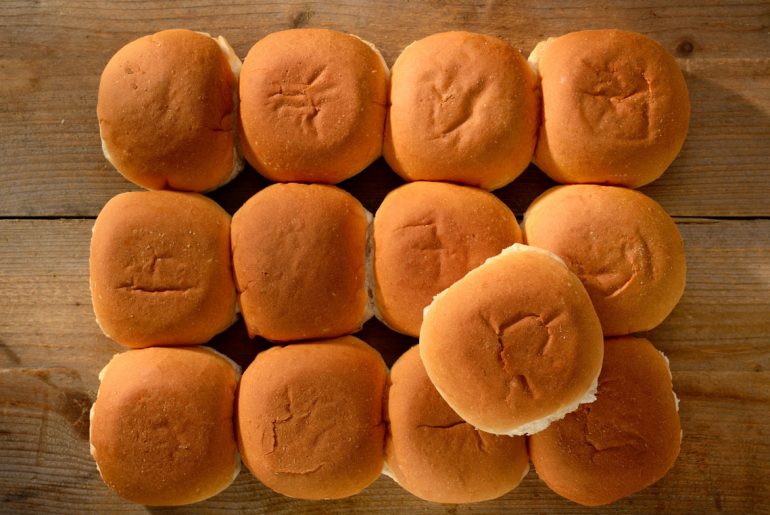Deviled eggs are a staple at brunches, potluck, picnics, and office luncheons — especially around the holidays. The little halved egg appetizer has been a favorite diners look forward to for decades. At this point, many families even have recipes going back several generations. Traditionally made with mayonnaise, mustard, and paprika, deviled eggs are devilishly delicious. So how did something so heavenly get a name so satanic? It turns out, the history goes back further than you think. The roots of the modern deviled egg recipe can be traced to ancient Rome, where the wealthy would be served boiled eggs seasoned with spicy sauces before the main meal. Eating eggs pre-meal was so common that the Romans even had a saying, “ab ova usque ad mala” — meaning from “eggs to apples”, or from the beginning to the end of a meal. Recipes for stuffed eggs began appearing in Andalusia, Spain…
The sweet history of Candy Corn
Every October, when the weather cools, we recognize that it’s time to start arguing about candy corn. But whether you think the little tri-colored candies are delicious or disgusting, no other candy is more iconic of Halloween. The history of candy corn and its place as a part of Halloween dates back more than a century ago. Though nobody knows for sure, candy corn is said to have been invented in Philadelphia by George Renninger, a candymaker for the Wunderle Candy Company. In 1898, George’s recipe rose to nationwide popularity when the Goelitz Confectionary Company picked it up and started marketing it as “Chicken Feed.” The candy packages pictured a rooster and a tag line that read, “Something worth crowing for.” The initial marketing was intended to appeal to Americans’ agricultural roots, and it was touted as a year-round treat. The Goelitz company, now known as Jelly Belly Candy Co., has the…
Bobbing for apples is a tradition based on love
All of the good holidays have traditions that we can look forward to. Whether it’s fireworks on the Fourth of July or turkey on Thanksgiving, every tradition has to start somewhere, and as it turns out, even Halloween’s bobbing for apples has a history. This year, as you plunge your head into a cold bucket of water in attempt to bite through the flesh of an apple, consider that the origins of this bizarre tradition are nearly 2,000 years old. Apples were once considered a symbol of love. In Scotland, the legend goes, a maiden would sit alone in a room and eat an apple in front of a mirror, whereupon the face of her husband would appear. In Montenegro, if a bride successfully threw an apple on the roof of her husband’s house, their union, it is said, would be blessed with children. In Greek mythology, Paris was tasked…
25 fun facts you never knew about apples
Crisp, sweet, and delicious, bushels of apples are a true symbol that autumn has arrived. Whether you stroll through the apple orchard and pick some yourself, or scoop a few pecks up from the store, Americans just can’t get enough. By volume, we eat more apples than any other fruit. But for all the love we show to apples, how much do you actually know about our favorite fall fruit? As you’re sipping on that warm glass of apple cider and snacking on some apples slices, consider these 25 fun facts about apples: 1. Archaeologists have found evidence that people have been eating apples since 6,500B.C. 2. The science of growing apples is called pomology. 3. There are more than 7,500 apple varieties in the world — about 2,500 varieties grown in the United States. About 100 of those are sold commercially. Apples are the second-most valuable fruit grown in the…
This is why a baker’s dozen is 13
Ask for a dozen roses from a florist or a dozen eggs from a farmer, and you’ll expect to receive an even 12 items. But if you ask a baker for a dozen doughnuts, you could go home with 13, or a baker’s dozen. Not that we’re complaining, but why do bakers have their own unit of measurement? The next time you’re snacking on that 13th bonus treat, you can thank crooked bakers back in medieval England. According to Encyclopedia Britannica, there were laws that regulated that a loaf of bread was worth the price of the wheat used to make it. Bakers caught overpricing undersized loaves — apparently a practice common enough to necessitate regulation — saw harsh penalties including fines, beatings, and jail time. Anyone who has ever made baked goods knows that getting them to come out the same size isn’t easy. In the Middle Ages, most…
This man invented the ice cream scoop and made summer a whole lot sweeter
Alfred L. Cralle died in a car accident nearly 100 years ago, but his invention continues to provide an essential part of your summer experience. July 15 is National Ice Cream Day, and while you’re feverishly shoveling spoonfuls of your favorite flavor into your mouth, it’s Cralle you can thank for those picture perfect scoops. While working as a porter in Markell Brothers drugstore and St. Charles Hotel in Pittsburgh, Pa, Cralle noticed that ice cream stuck to the spoons and ladles the servers used, and they usually had to use two hands to separate them. Cralle responded to this ice cream crisis by creating the ice cream scoop — originally called the Ice Cream Mold and Disher. It was designed to be strong, inexpensive and easy to operate with one hand. It had no moving parts that could break or malfunction. On February 2, 1897, thirty-year-old Cralle applied for and received the patent…
10 Facts you never knew about Chick-fil-A
Chick-fil-A is one of the most popular fast-food restaurants in the country today, but its history dates back to the 1940s when founder S. Truett Cathy invented the chicken sandwich at his original restaurant, the Dwarf House, in Hapeville, Georgia. It would be another two decades before he used that recipe and opened the first ever Chick-fil-A restaurant in Atlanta, Georgia. Today, the restaurant is predicted to become the third-largest fast-food chain in the country — a feat that would have it surpassing Wendy’s, Burger King, and even Taco Bell. Here are 10 facts you never knew about everyone’s favorite fast-food chicken restaurant. 1. The “A” in the name is symbolic The “A” at the end of “Chick-fil-A” isn’t just a fun play on the word chicken “fillet.” It also refers to the Grade A quality meat served at the restaurants. 2. Only three states don’t have Chick-fil-A restaurants Since opening the first…
You can thank this woman for your convenient frozen dinner
What’s for dinner tonight? If you’re considering anything that comes from the freezer, you can thank Mary Engle Pennington. Pennington, “The Ice Lady,” was a pioneer in food preservation. As the population of the United States shifted from the countryside into the city in the early 20th century, people began turning to grocery stores for their entire food supplies. The lure of the Industrial Age left families without the relative ease and safety of food they once had in their backyard farms. But there were no standards for safe food handling or storage at the time, and as a result, many frozen or refrigerated foods were rightfully deemed unsafe. Among other issues, people complained their foods arrived to their grocer spoiled, dried out and even moldy. Hundreds died and thousands became sick every year after consuming contaminated foods — particularly eggs, milk, fish and poultry. Pennington was a key scientist in the passage of the landmark…
The uncertain origins of the Christmas Pickle ornament
When it comes to holiday traditions, the Christmas pickle can be kind of a big dill — depending who you ask. Some families forgo hiding the odd ornament, yet in other homes it’s the most sought after item in the whole house. But where did this custom come from? Most people believe that hiding a pickle ornament somewhere in the tree is an Old World tradition that came to the United States with German immigrants in the 1800s. It’s said that whoever finds the pickle in the tree on Christmas morning will have good fortune in the coming year. In some families, the finder even gets a special present or gets to be the first to open his presents. But as it turns out, most Germans have never heard of the Christmas pickle, and you’d be hard pressed to find a German’s tree adorned with this garish green, sparkly decoration. Other stories of origin make…
12 Fun facts you didn’t know about candy canes
Candy canes are one of the most recognizable symbols (and foods) of the entire holiday season. While most people wouldn’t consider a Christmas complete with the red and white striped sticks, few people know much about their long history. Whether you use one to stir your hot chocolate or just hang them on your tree, here are 10 fun facts about this iconic candy. 1. They are very old The first reference to candy canes in America dates back to 1847 when a German immigrant from Wooster, Ohio decorated his Christmas tree with the festive candy. Candy canes weren’t commonly hung on trees until 1882, but the first candy canes predate these events by a few hundred years… 2. origins Folklore says that in Cologne, Germany in 1670, a choirmaster at the Cologne Cathedral, wishing to keep the local children quiet during the Living Creche tradition of Christmas Eve, asked a candy maker to form…










